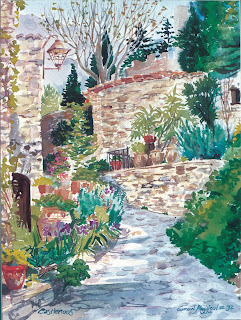During a recent watercolor class at Reddi Arts, I realized, while trying to explain what I was doing to the students, that I was really "painting with light"! Watercolor is a different kind of painting experience, a lot like herding cats. With oils and acrylics you can force the medium to comply with your intention, by correcting ad infinitum. With watercolors you don't have the luxury of "fixing" your mistakes easily. You have to cautiously plan out your moves in advance, requiring forethought and skill. Mostly you are putting the lightest colors from the sun, on first. I put these on with yellows or golden tones made of raw sienna, and work around the color wheel to the cool colors. I save the darkest accents til last, not rushing to them too soon. Here below is a mediteranean scene from Eze, France, I downloaded the photo from Pinterest. It served as a good example of bounced light into interior spaces, such as the garden left corner.

My approach to watercolor is a bit different and was another part of the lesson plan. I do not do preliminary drawing first. This of course is scary to
most, but if you are brave enough and have reasonably good drawing
skills, and OBSERVE the subject for a long time you may find my method
is faster and renders a more light filled result. I lay in the lightest
color first as shown below
While the drawing is being developed I am using a lot of water in my mix
changing colors from warm to cool in the spaces as needed , and letting
the colors bleed or "wick" a bit into each other naturally. This gives
the final work a more light filled look. It is as if I am
"painting with light"!
With stone details I try to understate them a bit
to keep them from looking overworked and stiff.
I will add the darker stone shadows later.
I try to be cognizant of the the light and where it must be brightest,
ALWAYS reserving it in some light version. Once it is gone, it is gone,
so pay attention to the light. I concentrate on the lighter versions of the
color of the shadow areas, waiting til later to move to stronger shadows.
I wanted to get the trees in, although I will go back in and add more depth to
the cottage shadow wall later. First I wanted to see the wall in context of the
background trees to know exactly how deep to make my shadow glaze mix.
Doing the green, I starting with a warm yellow mix first wetly. To that I would
add the various greens letting them wick into the yellows, painting negatively
where the foreground bushes meet the background cypress.
Next I needed to start preparing where the overhanging tree would go
so I could map out the sky colors so as not to place too much blue
where later I would need light yellows for the leaves. I used light
yellow sienna washes here too, adding slowly the burnt sienna and blues
later directly next to the yellow wet washes to allow for a natural look.
Below: You can detect the tree has mostly dried. While this was happening
I took the opportunity to add deepened dark neutrals into the wall shadow
and behind the palm fronds. Different levels of chrome green washes and
bright yellow glazes emphasize the shadow and the light on the frond leaves.
The tiles received a bit of detail glazes in cerulean blue cool tones, contrasted
by burnt sienna warms.
Below: I tend to believe a bit less blue is better than too much. I actually did
the water seaand island first, doing the sky color last. Water and cerulean blue
mixed with horizon blue create sea and sky. Some purple is in the island.
Below: I started introducing bright yellows where the leaves were to go.
Into that I would plan to add different yellow sienna and chrome greens,
maintainingbright light filled leaves.
It is important to create some dark leaves occasionally placed to
"lead the eye" for composition. I added a few understated branches and a
few darker greens for visual interest.
Above: The final painting "Eze" Provence, 31cm X 41cm
(12"X16" on Arches watercolor cold pressed paper)

